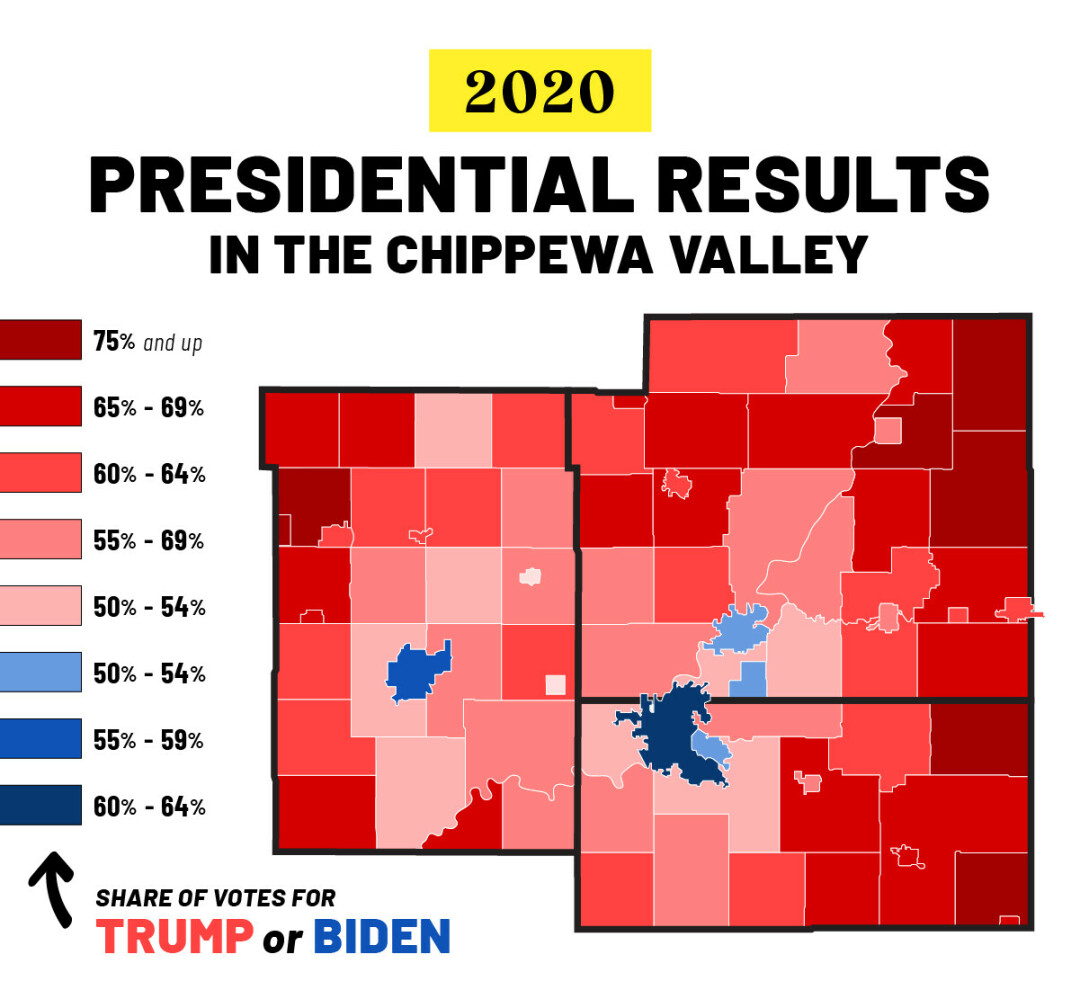Four Election Takeaways from the Chippewa Valley
outcome of Trump-Biden race shows deepening red-vs.-blue trends
You survived the 2020 general election. Congratulations! Now that another massive round of voting is complete, in one of the highest-turnout elections in state and national history, how do we make sense of the results? And how do the results in the Chippewa Valley compare to prior patterns – the patterns discussed in part one of this story back in October?
Once again, we’re using what we’ll call the Chippewa Valley Partisan Voter Index (CVPVI) – a local variation of the Cook Political Report’s national PVI measurement – to assess assorted municipalities across western Wisconsin. The CVPVI reflects the partisanship of a given city/county compared to the statewide two-party (Republican and Democratic) result of either a presidential or gubernatorial race in general elections going back to 2004. This way, we get a better feel for how these areas are evolving politically. Going over the numbers, here are some of the biggest takeaways.
There’s a lot of Republican red on the map of results from the 2020 presidential election in the Chippewa Valley. In this map – which shows results in all the municipalities in Dunn, Eau Claire, and Chippewa counties – the only communities where the majority of voters cast ballots for Democratic President-Elect Joe Biden were the cities of Eau Claire, Chippewa Falls, Menomonie, and Altoona, and the Town of Hallie. The bluest spot on the map is the City of Eau Claire, were about 62% of the vote went to Biden, while the reddest are is the Town of Fairchild, in the far southeast corner of the map, where 79% of votes went to President Donald Trump.

1. Many New Voters ARE for Donald Trump
As previously mentioned, turnout jumped across the country and throughout the Badger State. The same effect is found in the cities, counties, and townships we’ve used to represent the Chippewa Valley. In smaller cities and rural county areas, that increased turnout was accompanied by the highest Republican general election vote totals and Republican-oriented CVPVI numbers in all of our historical research.
The cities tracked for this project on election trends are Eau Claire, Chippewa Falls, Menomonie, Altoona, Bloomer, Boyceville, Durand, Lake Hallie, Mondovi, Elk Mound, Colfax, Cadott, Fall Creek, Augusta, Osseo, and Eleva. The first four were the only ones sporting a Democratic CVPVI in the 2020 presidential election. Of the remaining cities, two of those smaller ones had a CVPVI showing a Republican advantage of at least 10 percentage points (R+10) in any of the three previous general elections; in 2020, seven hit R+10 or greater.
Interestingly, not all voters in these rural communities went straight-ticket GOP. In Osseo and Eleva, Democrat Ron Kind won a majority of the votes cast in the 3rd Congressional District race, even as Donald Trump carried those same cities in the presidential contest. Given that some of these places used to have CVPVI ratings above D+5, there are likely former straight-ticket Democrats voting for Kind and Trump.
2. The Urban/Rural Split Is Widening
On the opposite side of the big Republican/Trump margins in smaller cities, Eau Claire stayed strongly Democratic, with its third straight general election featuring a CVPVI of D+13. Yet the non-Eau Claire part of its county was R+4 – another record-high GOP rating going back to 2004. Chippewa County had a similarly dramatic split in partisanship: Chippewa Falls was D+1, while the rest of Chippewa County was R+13.
3. Some Growing Rural Turnout
The non-Eau Claire and non-Chippewa Falls parts of Eau Claire and Chippewa counties also had 0.68% and 0.87% of all two-party votes cast statewide – the highest percentage share either county has had of all Wisconsin votes for Democratic and Republican presidential and gubernatorial candidates going back to the ’04 general election. This very well may have powered the stronger Republican numbers in non-urban parts of those counties.
4. Shifting Shades of Blue
Including only voting wards with at least 10 ballots cast, all but one of Eau Claire’s wards voted for Joe Biden. Comparing the 2020 city results to prior elections, one can see levels of Democratic support moving around the city. As the downtown gets closer to a navy hue with Democratic percentages above 70%, a deepening blue can be seen spreading around Vine Street and Moholt Drive, and across the south part of Eau Claire toward the Oakwood Hills area – the latter traditionally one of the more split or Republican-leaning parts of the city.
”
While the days of places throughout the Chippewa Valley swinging back and forth from Democratic to Republican candidates are likely gone for the foreseeable future, the margins are – to use a common term in political data circles – elastic.
Despite a nearly even split 2020 presidential election in Wisconsin, there is an open question as to whether that contest was based around typical Republican and Democratic support or if Trump’s presence altered traditional patterns. A fair interpretation of the rural/small-city vote in the Chippewa Valley is that support for Trump – and/or possibly an effective get-out-the-vote effort by the local Republican Party – got many people to cast ballots who otherwise would not have voted. This might also explain why the final vote margin in Wisconsin was far tighter than what was predicted by most polls – new Trump voters may have not been captured by polling outfits, or refused to take part in the surveys.
Are these new voters drawn specifically to Trump? Will they skip voting in future elections if Trump is not on the ballot, or can they be turned into reliable voters for Republican candidates? If the answer to the latter question is yes, the non-urban landscape of western Wisconsin – like similar landscapes nationwide – could be a sea of strong Republican support that could tip close statewide races to the GOP.
By that same token, the continued swing toward Democratic candidates seen in the upper-middle class parts of Eau Claire was also seen in suburban Milwaukee (and in suburbs throughout the United States). Were these voters pushed to choose Joe Biden just this time because of Trump, or are they now going to regularly vote for Democrats in other races?
While the days of places throughout the Chippewa Valley swinging back and forth from Democratic to Republican candidates are likely gone for the foreseeable future, the margins are – to use a common term in political data circles – elastic. Candidates will still matter. Generations will age into greater electoral influence carrying different priorities than older groups, and demographic coalitions may switch allegiances accordingly. As long as we make the effort to vote like so many of us did in 2020, we can survive any election.
VOTE TOTALS BY COUNTY IN THE CHIPPEWA VALLEY
| COUNTY | Votes for Biden | Votes for Trump |
| Chippewa Co. | 13,983 | 21,317 |
| Dunn Co. | 9,897 | 13,173 |
| Eau Claire Co. | 31,620 | 25,341 |
| TOTAL | 55,500 | 59,831 |
| PERCENTAGE* | 47.1% | 50.8% |
* Percentage accounts for third-party votes.
Source: Wisconsin Elections Commission

